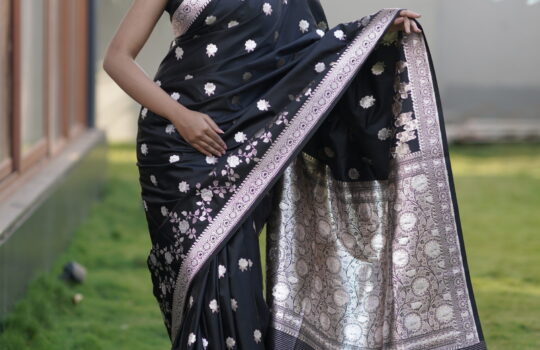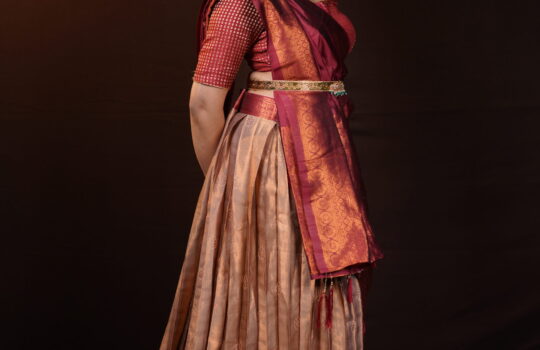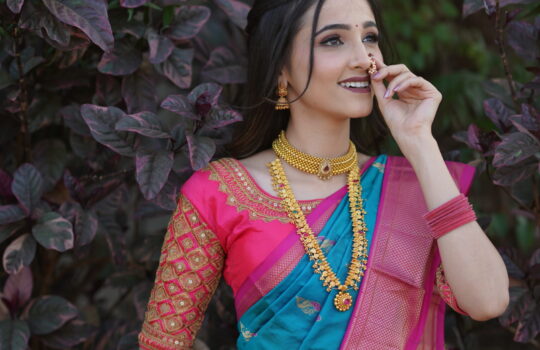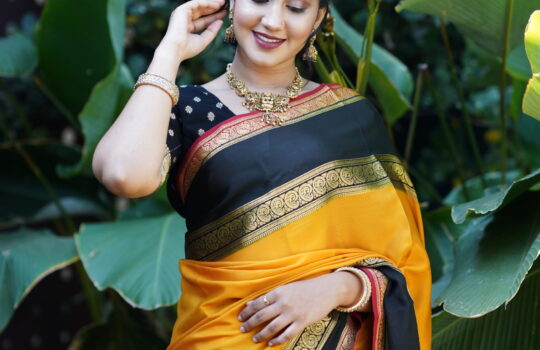Discover the Rich Elegance of Tussar Sarees – From Festive Glam to Daily Elegance – Preeti Silks
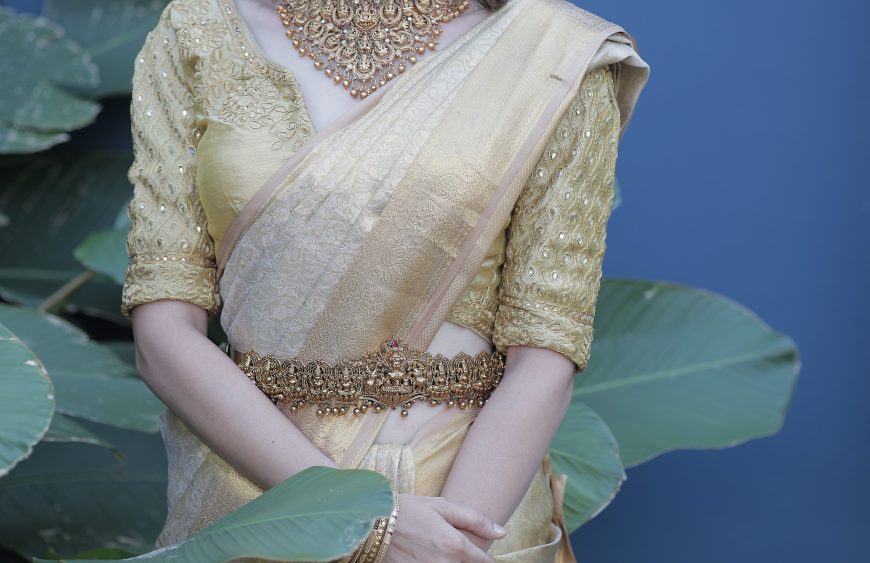
Tussar saree, often referred to as the “wild silk” of India, occupies a distinctive spot among India’s vast textile tapestry. Prized for its golden sheen, soft texture and slightly coarse feel, Tussar sarees are prized for their raw beauty and understated elegance. Primarily found in states such as Jharkhand, Bihar Chhattisgarh West Bengal where skilled artisans continue their heritage with every yard of silk they produce.
Tussar silk differs from conventional mulberry silk in that its fabric is produced by silk worms that reside in wild forest trees, giving it its distinctive texture and earthy charm, which make it lighter, breathable, and suitable for India’s tropical climate. This unique source often leaves its natural shade unaltered; or can even be dyed vibrant colors to highlight its versatility and beauty.
Tussar silk sarees are known for their intricate patterns inspired by nature; leaves, trees, flowers and tribal art forms often make an appearance when handloom weaving or embroidery techniques are employed to weave them into fabric fabric. Tussar sarees provide the ideal balance of rustic charm and luxurious grace that make them suitable for both festive events as well as daily wear.
Tussar silk is now revered not only for its beautiful aesthetics but also for its eco-friendly production process, which involves minimal human intervention and provides sustainable livelihoods for rural artisans. Modern designers and brands alike have taken notice of Tussar silk’s ability to blend seamlessly with contemporary styles while still preserving its classic essence.
At Preeti Silks Hubli, we celebrate the legacy of Tussar by offering an authentic handwoven Tussar silk saree collection. Perfect for special events like weddings and festivals as well as everyday wear, Tussar silk is an enduring choice which embodies sophistication, culture, and natural beauty – perfect no matter the occasion or your attire choice.
The Art of Weaving Tussar Sarees – A Journey of Tradition and Grace
Tussar silk saree weaving is a testament to tradition, craft, and patience. Renowned for their luxurious texture and natural golden sheen, these elegant garments are intricately handwoven by skilled artisans from across Jharkhand, Bhagalpur, Chhattisgarh, and West Bengal regions.
Tussar silk production starts by cultivating wild Antheraea mylitta silkworms that inhabit trees such as Sal, Arjun and Asan in their natural habitat. These species thrive without human intervention resulting in Tussar’s unique blend of coarse yet soft fabric characteristics that give it such a distinct appearance and feel.
Once silkworms spin their cocoons, their raw silk is extracted. Historically, this was done manually to preserve its natural colors and textures of yarn. Next, this silk is spun into threads for weaving; dyed earthy or vibrant hues may then be applied before weaving begins – often leaving behind its golden glow which connoisseurs highly prize.
Crafting a Tussar saree requires both time and precision. Utilizing handlooms, artisans carefully interlace warp and weft threads into intricate patterns reflecting nature, folklore and cultural heritage – such as leaves, trees, flowers or tribal art – which can often be rendered through intricate embroidery work or built directly into fabric itself.
Bhagalpur weaver’s specialize in creating rustic yet lightweight looks while artisans in Chhattisgarh experiment with heavier textures and traditional designs. Tussar sarees made here often incorporate hand-painted madhubani tribal art as well as hand zari borders for an exquisite finishing touch, creating wearable works of art.
Modernization may have changed many traditional artisans’ techniques, yet many artisans continue to employ age-old processes that guarantee each saree reflects handcrafted authenticity. Any uneven texture or organic imperfections found are signs that this authentic handmade Tussar weaver was involved. At Preeti Silks Hubli, we proudly honor the Tussar weaving tradition by offering exquisite Tussar silk sarees directly from skilled artisans. Every drape you wear is an homage to their hours of labor and artistry in creating these timeless pieces – they bring the past alive.
What’s New in Tussar Sarees for 2025 – Trends You Can’t Miss
Tussar silk’s raw texture and natural sheen has long captivated saree lovers around the globe, and now in 2025 they are making even stronger comeback. If you are planning an ethnic wardrobe upgrade this year then here are the key trends you should watch: Tussar sarees.
- Earthy and Pastel Tones While golden-beige Tussar silk remains timeless, 2025 ushers in a welcome change with earthy neutrals, pastel pinks, sage green, muted mustard and lavender hues making their debut on Tussar fabric. These subtle shades enhance its natural beauty for casual as well as festive occasions alike.
- Hand-Painted Motifs and Tribal Art Artisan-led designs are taking center stage. Look out for hand-painted Madhubani, Warli and tribal motifs on Tussar sarees; these artistic designs not only add personalization but also reflect India’s rich cultural histories – turning every saree into an eye-catching statement piece.
- Minimal Zari and Border Work Heavy embellishments have taken a backseat; instead, minimalist zari borders with subtle gold highlights and delicate embroidery are becoming the look of choice, creating an elegant aesthetic that fits both modern and traditional tastes alike.
- Contemporary Blouse Pairings Tussar sarees can now be styled with statement blouses – such as high-neck collars, embroidered jackets and trendy sleeveless cuts – that add bold, fashionable appeal. Combine rustic silk fabrics with modern silhouettes for an interesting, fresh take on traditional wear.
- Sustainable and Handwoven Collections With growing consumer interest in eco-fashion, handloom Tussar sarees created through ethical, eco-friendly processes are becoming more desirable. Buyers now seek sarees that not only look beautiful but also support artisan communities and eco-friendly production.
At Preeti Silks Hubli, Tussar Saree Collection celebrates these exciting trends, offering the perfect balance of tradition and modern style. Whether you prefer earthy colors or sleek minimalistic designs, you are sure to find your ideal Tussar drape with us. Don’t fall behind on fashion. Tussar silk has become more than fabric: it is now an expression of fashion statement.
Sustainable Style: How Tussar Silk Supports Eco-Friendly Fashion
Tussar silk stands out as an eco-friendly fashion choice in an age when sustainability has become a primary focus. Unlike synthetic or heavily industrialized textiles, its organic production process and reduced environmental impact makes Tussar silk an exceptional fashion option.
Tussar silk, often referred to as “wild silk,” is produced by silkworms found living and feeding naturally on trees such as Sal, Arjun and Asan in forests across Southeast Asia. As these silkworms do not live and feed within controlled farms but instead remain undisturbed within their wild habitat, this non-invasive rearing method means less disturbance for the environment and biodiversity preservation.
Harvesting and weaving Tussar silk are typically carried out manually with minimal use of machines or chemicals, reducing carbon emissions compared to mass-produced synthetic fabrics. Natural dyes may be employed when coloring Tussar silk to further reduce chemical waste and water pollution. Ultimately, this artisan-driven approach not only sustains the environment, but also benefits rural communities while upholding ancient weaving traditions.
Tussar silk’s biodegradability is another eco-friendly benefit. While synthetic fabrics take centuries to break down, Tussar silk biodegrades over time without harming soil or water sources. Plus, its production requires significantly less water compared to crops like cotton – making it a much more sustainable solution.
Tussar silk not only is eco-friendly, but its durability and versatility also makes it a valuable addition to a sustainable wardrobe. When properly maintained, Tussar sarees can last decades with proper care reducing replacement needs significantly and providing greater longevity than its alternatives.
Preeti Silks Hubli takes great pride in offering authentic handwoven Tussar silk sarees that embody eco-friendly luxury. Our 2025 collection offers stunning yet ethical fashion choices to help reduce environmental impact while remaining stylish. Choosing Tussar silk doesn’t just represent elegance; it represents living a life that honors nature, tradition and sustainability.
What Is a Tussar Saree?
A Tussar saree is an iconic Indian garment made of Tussar silk that’s known for its natural golden sheen, slightly coarse texture, and light feel. Crafted by artisans across Jharkhand, Bihar, Chhattisgarh and West Bengal regions it makes for great festive as well as daily wear options.
How Does Tussar Silk Differ From Regular Silk?
Unlike regular mulberry silk, Tussar silk is produced by wild silkworms in natural forests feeding off trees as their food source, giving it its unique golden color and lighter, breathable quality that make it suitable for tropical climates.
Are Tussar Sarees suitable for Weddings and Festivals?
Tussar sarees are ideal for weddings, festivals and formal events due to their luxurious texture, elegant drape and intricate designs – offering both comfort and luxuriousness for celebrations! They can also be combined with embellished blouses for an opulent appearance
How Should I Maintain My Tussar Silk Saree?
To achieve maximum results from dry-cleanning your Tussar saree, dry cleaning should always be the preferred choice, especially initially. If handwashing, use mild detergent in cold water. When drying in shaded conditions and storing in cool dry place (preferably wrapped with muslin cloth for best results) should ensure softness and sheen.
Is Tussar Silk Eco-Friendly?
Absolutely. Tussar silk production relies on wild silkworms found in natural forests and requires minimal water usage, as well as traditional handloom weaving methods used by rural artisans who support eco-fashion practices.


